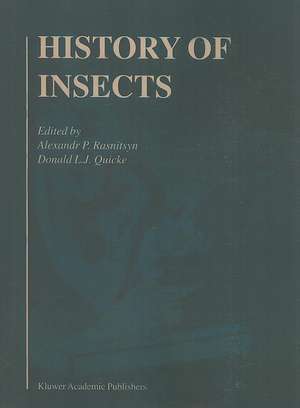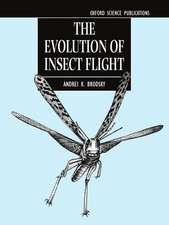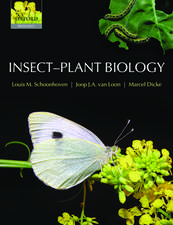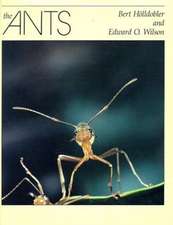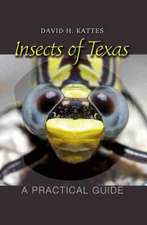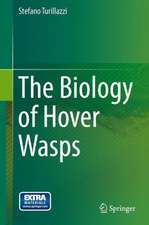History of Insects
Editat de Donald L. Quickeen Limba Engleză Paperback – 7 dec 2010
It is the product principally of the largest palaeoentomological group in the world, in Moscow, and makes full use of the remarkable collection that these workers have developed. It includes a very large number of phylogenetic framework, with information on fossil groups being used to help interpret relationships. An appendix provides information on virtually all sites where fossil insects have been found. This book is essential to all students of palaeoentomology and contains a wealth of information that will be of interest to students of insect evolutionary relationships and palaeontology in general.
The Paleontological Institute, Russian Academy of Sciences (Moscow), is the world’s largest team of paleontologists, with 263 total staff and 117 paleontologists (as of January 2000) in 12 research departments and in the Yu. A. Orlov Paleontological Museum.
| Toate formatele și edițiile | Preț | Express |
|---|---|---|
| Paperback (1) | 3041.93 lei 6-8 săpt. | |
| SPRINGER NETHERLANDS – 7 dec 2010 | 3041.93 lei 6-8 săpt. | |
| Hardback (1) | 3049.02 lei 6-8 săpt. | |
| SPRINGER NETHERLANDS – 31 mai 2002 | 3049.02 lei 6-8 săpt. |
Preț: 3041.93 lei
Preț vechi: 3709.67 lei
-18% Nou
Puncte Express: 4563
Preț estimativ în valută:
582.26€ • 632.67$ • 489.41£
582.26€ • 632.67$ • 489.41£
Carte tipărită la comandă
Livrare economică 21 aprilie-05 mai
Preluare comenzi: 021 569.72.76
Specificații
ISBN-13: 9789048158300
ISBN-10: 9048158303
Pagini: 532
Ilustrații: XII, 517 p.
Dimensiuni: 210 x 279 x 28 mm
Greutate: 1.23 kg
Ediția:Softcover reprint of the original 1st ed. 2002
Editura: SPRINGER NETHERLANDS
Colecția Springer
Locul publicării:Dordrecht, Netherlands
ISBN-10: 9048158303
Pagini: 532
Ilustrații: XII, 517 p.
Dimensiuni: 210 x 279 x 28 mm
Greutate: 1.23 kg
Ediția:Softcover reprint of the original 1st ed. 2002
Editura: SPRINGER NETHERLANDS
Colecția Springer
Locul publicării:Dordrecht, Netherlands
Public țintă
ResearchCuprins
to Palaeoentomology.- Class Insecta Linné, 1758. The Insects (=Scarabaeoda Laicharting, 1781).- General Features of Insect History.- Appendix: Alphabetic List of Selected Insect Fossil Sites.
Notă biografică
Textul de pe ultima copertă
This is the first time that a single book has attempted to cover the whole of the fossil history of insects, so comprehensively. The volume embraces the history of insect paleontology, the methods for studying fossils, the taphonomic processes leading to their formation, the diagnostic features of all insect orders, both extant and extinct, the major fossils of each order, and the implications that can be drawn from the palaeoentomological record about past ecology and climates. Many new insights are presented.
It is the product principally of the largest palaeoentomological group in the world, in Moscow, and makes full use of the remarkable collection that these workers have developed. It includes a very large number of phylogenetic framework, with information on fossil groups being used to help interpret relationships. An appendix provides information on virtually all sites where fossil insects have been found. This book is essential to all students of palaeoentomology and contains a wealth of information that will be of interest to students of insect evolutionary relationships and palaeontology in general.
The Paleontological Institute, Russian Academy of Sciences (Moscow), is the world’s largest team of paleontologists, with 263 total staff and 117 paleontologists (as of January 2000) in 12 research departments and in the Yu. A. Orlov Paleontological Museum.
It is the product principally of the largest palaeoentomological group in the world, in Moscow, and makes full use of the remarkable collection that these workers have developed. It includes a very large number of phylogenetic framework, with information on fossil groups being used to help interpret relationships. An appendix provides information on virtually all sites where fossil insects have been found. This book is essential to all students of palaeoentomology and contains a wealth of information that will be of interest to students of insect evolutionary relationships and palaeontology in general.
The Paleontological Institute, Russian Academy of Sciences (Moscow), is the world’s largest team of paleontologists, with 263 total staff and 117 paleontologists (as of January 2000) in 12 research departments and in the Yu. A. Orlov Paleontological Museum.
